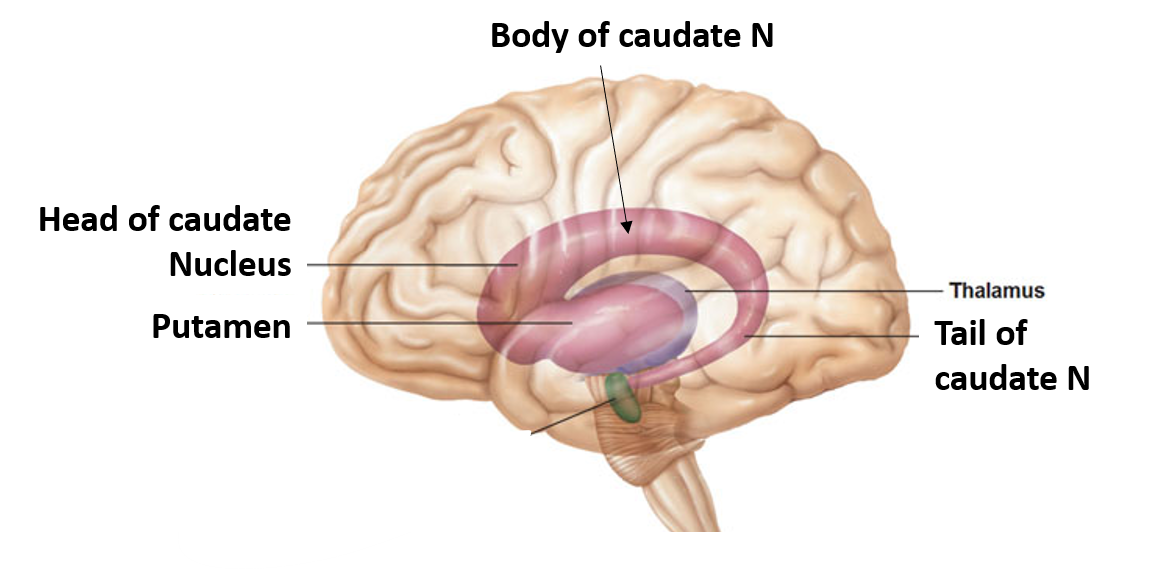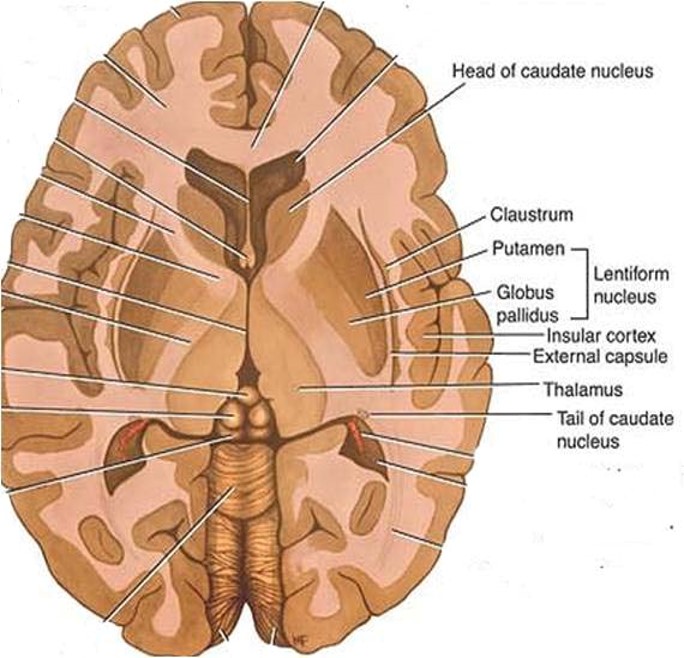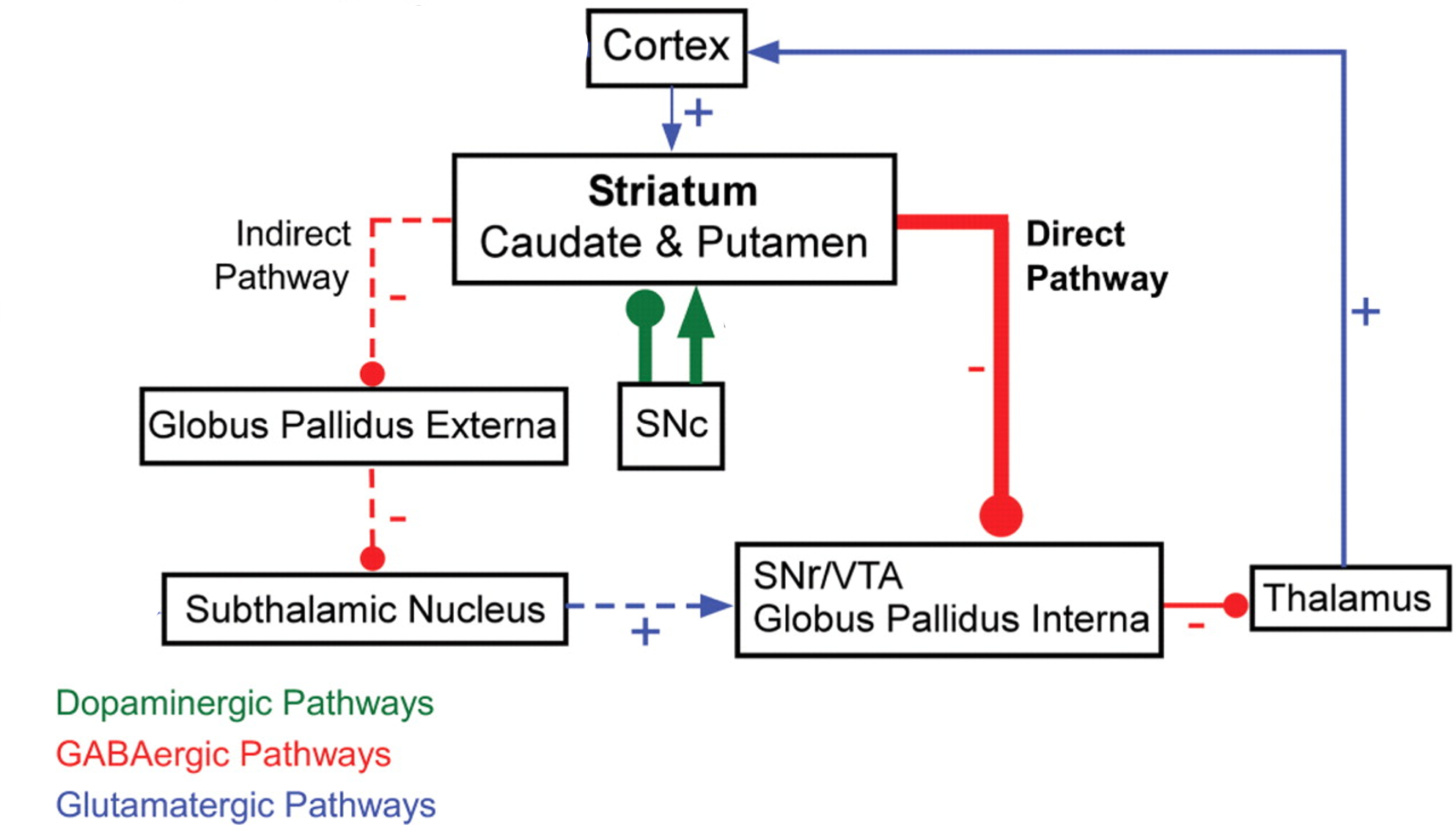What are the components of Basal ganglia/nuclei.
Basal gangli/nuclei are the collection of masses of grey matter situated within the white core of cerebral hemisphere. They are essential component of extrapyramidal system. They consist of following components or nuclei.
- Corpus striatum
- Caudate nucleus
- Lentiform nucleus which is further divided into putamen and globus pallidus.
- Claustrum
- Subthalamic nucleus
- Substantia nigra
On the basis of evolutionary development/phylogeny nuclei are divided into following three types:
- Neostriatum: Caudate + Putamen
- Paleostriatum: Globus pallidus
- Archistriatum: Amygdaloid Nucleus +Claustrum
Describe briefly the parts of Basal ganglia.
Caudate nucleus
It is a C- shaped mass of grey matter. Its parts are head, body and tail. The head is fused inferiorly with lentiform nucleus and the tail of caudate nucleus ends in relation to amygdaloid complex.
 Lentiform Nucleus
Lentiform Nucleus
It is a large lens shaped mass of grey matter. It appears triangular (wedge shaped) in cross section. It is divided by a thin layer of white matter into
- Lateral part :Putamen
- Medial part : Globus pallidus . It is further subdivided into The globus pallidus can also be divided into two parts:
- globus pallidus externa (GPe)
- globus pallidus interna (GPi).
Claustrum
It is a thin mass of grey matter situated between the putamen and insula.
Subthalamic nucleus
It is located caudal to thalamus.
Substantia nigra
It is a motor nucleus located in midbrain. It consists of two parts – pars reticulata and pars compacta. Its neurons synthesize and secrete dopamine.
What are the functions of Basal ganglia/Nuclei?
Following are the functions of Basal Ganglia/Nuclei:
- Programming of voluntary movements: Instructions for learned muscular movements are stored in basal ganglia. When a learned movement is to be carried out the information is transmitted to thalamus from there to premotor area and then to motor cortex.
- Regulation of automatic movements: It controls the automatic movements such as swinging the arm while walking.
- Inhibit unwanted muscular movements.
- Regulation of muscle tone and help in smoothening the voluntary motor activities.
Describe briefly the connections of basal nuclei.
Following are the connections of the basal nuclei:
- The caudate and putamen receive all the afferents (input) of basal nuclei. They receive afferents chiefly from three sources:
- Cerebral cortex -Costicostriate fibers
- Thalamus – Thalamostriate fibers
- Substantia nigra – Nigrostriate fibers
- Efferents from caudate nucleus and putamen mainly go to global pallidus, few to substatia nigra.
- Efferents from the globus pallidus and substatia nigra form the efferent connections of basal nuclei. The efferents from them go to :
- Thalamus
- Subthalamic nuclei
- Superior colliculus
- Reticular nuclei

- There are two pathways by which basal nuclei circuit influences motor cortex. These are:
- Direct pathway: Stimulates motor cortex
- Indirect pathway: Inhibits motor cortex
- Cortical areas involved in the planning and execution of movements (primarily premotor cortex) project to the caudate and putamen.
- They then project to the globus pallidus, which in turn projects to the thalamus (ventral anterior and ventral lateral nuclei).
- Thalamus in turn projects to motor cortex which is responsible for execution of movement and sends descending fibers (pyramidal tracts) to the anterior horn ( motor neurons) of opposite half of the spinal cord.
Some important facts to remember:
- There are no fibers that go directly from the basal ganglia to the spinal cord.
- Basal ganglia affects movements of the contralateral body.
Applied Aspect
Disorders of Basal Ganglia
The lesions of Basal nuclei occur when they fail to act proper infornation to cerebral cortex to suppress unwanted movements or to initiate motor activity. there are two types of disorders:
- Hypokinetic: lack or slowness of movements:
- Parkinson’s disease
- Hyperkinetic : Excessive and abnormal movements.
- Chorea
- Athetosis
- Ballism
Parkinsonism
This occurs due to deficiency of dopamine which is secreted by substantia nigra. Is characteriszed by:
- Resting tremors
- Muscular rigidity ( cogwheel type)
- Pin rolling movements of hands
- Mask like face
- Stiff shuffling gait
- Stooped posture
- Absence of associated movements like arm swinging during walking.
For treatment : L-dopa, a precursor of dopamine is administered because dopamine cannot cross the blood brain barrier.
Chorea
Is characterised by brisk, jerky, and purposeless movements. It Involves primarily tongue, face and limbs i.e swift grimaces and sudden movements of head or limbs .It is of two types:
- Sydenham’s chorea
- Hutington’s chorea
Differences between Sydenham’ and Hutington’s chorea
Sydenham/s Chorea Hutington’s Chorea Age Occurs in children ( age 5-15 years) Occurs in adults ) age 30-45 yrs.) Pathology Abs produced against streptococcal bacteria binds to proteins of membrane of neurons of caudate N and putamen Degeneration of GABA secreting neurons of caudate N and putamen Involuntary movements Relatively less rapid and jerky. Relatively more rapid and jerky CT scan of brain Shows no significant finding Shows enlarged lateral ventricle due to degeneration of caudate nucleus. Recovery Full recovery No recovery
Athetosis
Is characterizezd by slow, sinous and writhing movements that involve distal segments of the limbs. Results due to lesion of neostriatum and globus pallidus breaking the neural circuitary between basal nuclei & cerebral cortex.
Hemiballisimus
Occurs due to vascular lesion of subthalamic nucleus. It is characterized by violent burst of irregular movements in the trunk, girdle and proximal muscles of extremities of opposite side.Limbs suddenly flies about in all directions.

This is a wonderful and well elaborated approach to understanding what matters with respect to the above subject
Very powerful article